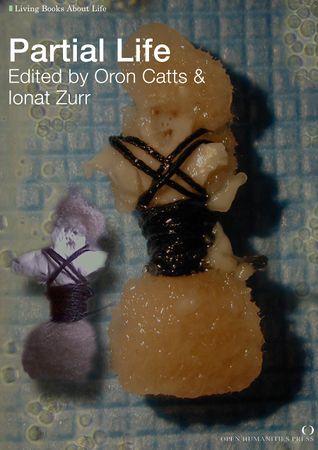Partial life/the semi-living

Introduction:
This Living Book is partially living – it is about the Semi-Livings and Partial Lives, tissues without a body .While the biological body cannot survive without organs and cells the latter two groups can survive in technological body, removed and separated form their original biological body. Living fragments of biological bodies, lab grown life- reconfigured, mixed and remixed, reappropriated, recontextualised and instrumentlised. The semi-livings require different epistemological and ontological understandings as well as considerations and, by extension, a different taxonomy of life. The Liminality of this type of technological approaches to life can lead to a form of fetishism - Neolifism. The Semi-livings and Partial lives are a new class of objects/beings, in most cases they constitute of living and non-living materials; cells and/or tissues from a complex organism grown over/into constructed scaffolds and kept alive with an artificial support. They are both similar and different from other human artefacts (homo-sapiens’ extended phenotype) such as constructed objects and selectively bred domestic plants and animals (both pets and husbandry). These entities are living biological systems that are artificially designed and need technological intervention in their isolation, construction, growth and maintenance. Semi-living and partial life can be seen as interchangeable terms. There are however some nuances; The Semi-Livings entities are usually shaped to forms that are not recognisable as being part of any Body in particular, partial life can be recognised as parts (i.e. an ear, or tissues) of a whole of a living being. Symbolically, in the continuum of made life, the semi-livings entities are nearer to the constructed part of the scale, while objects of partial life are approaching the grown. The "population" of what can be referred to as partial life and semi-living entities proliferated to a vast amount of cells and tissues that are living and growing outside of the organisms from which they originated. A rough estimate would put the biomass of living cells and tissues, which are disassociated from the original bodies that once hosted them, in the millions of tons. In addition, there are tons of fragments of bodies (cells, tissues, organs) that are maintained in suspended animation in cryogenic conditions ( http://www.frozenark.org/ ) . All of this biomass requires an intensive technological intervention to prevent transformation to a non-living state. These beings are rarely referred to as subjects; their existence (supported by the techno-scientific project) is indicative of the transformation of life into raw material that manifests itself in utilitarian and economic value. This edition of Living Book will try “to give them a voice” by presenting their history, and some examples of their use (and existence) with the aim to raise the problematics they may presents which are a reflection of current society: A society which attempt to cope with a growing gap between the rapidly increasing knowledge and technological ability to manipulate life, and the long rooted values towards life which are still lurking behind; a society that may be facing its own extinction as a result of ecological crisis and in urgent need to reconsider the Judo-Christian view of dominion over “nature” in favour of a more post-humanist agenda. Having control over life, its processes and the environment as whole may have always been the basis for human endeavour. What changing are the attitudes towards life resulting from the accumulation of scientific knowledge and technological capabilities, mounting up with increasing speed and scale of manipulation. A choreographed interplay between hype and actuality is overlaid on a public that is bombarded with information that should excite and disturb but is also easily forgotten. As the perception of the level of control over the matter of life increases, it seems that whereas previously biologists were employing their understanding of engineering to the life sciences, now it is the engineers who force-fit engineering methodologies into living systems; life is becoming bio-matter, waiting to be engineered.
- redirect [|read more]]
